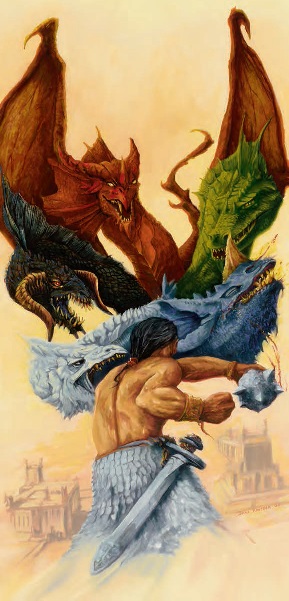Trailokya (Sanskrit: त्रैलोक्य; Pali: tiloka, Wylie: khams gsum) has been translated as 'three worlds,'[1][2][3][4][5] 'three spheres,'[3] 'three planes of existence,'[6] 'three realms'[6] and 'three regions.'[4] These three worlds are identified in Hinduism[citation needed] and appear in early Buddhist texts.

In Buddhist cosmology[edit]
After Life Destruction are the three great realms of Divine Sea, Divine Transformation, and Divine Lord. Each of these three large boundaries are divided into three small boundaries of early, middle, and late stages. Three small boundaries within three large boundaries, that is a total of nine. Background Edit 1229 DR Manshoon was born to the mighty warrior Harlshoon, commander of the Zhentilar and First Lord of Zhentil Keep.He had a brother, Asmuth. 1258 DR Three months after they sent their respective sons out on adventure throughout the Realms, Lord Calkontor, father of Chess, poisoned his political rival Harlshoon.While Calkontor was busy mocking the dying warrior, Lord Harlshoon.
In Buddhism, the three worlds refer to the following destinations for karmic rebirth:

- Kāmaloka the world of desire, typified by base desires, populated by hell beings, preta, animals, ghosts, humans and lower demi-gods.
- Rūpaloka is the world of form, predominately free of baser desires, populated by dhyāna-dwelling gods, possible rebirth destination for those well practiced in dhyāna.
- Arūpaloka is the world of formlessness, a noncorporeal realm populated with four heavens, possible rebirth destination for practitioners of the four formlessness stages.[3]
Theosophical views[edit]
According to Helena Blavatsky's posthumously published Theosophical Glossary (1892):

- Kamaloka (or kamadhatu) is the world of Mara. Kamaloka has, like every other world, its seven divisions, the lowest of which begins on earth or invisibly in its atmosphere; the six others ascend gradually, the highest being the abode of those who have died owing to accident, or suicide in a fit of temporary insanity, or were otherwise victims of external forces. It is a place where all those who have died before the end of the term allotted to them, and whose higher principles do not, therefore, go at once into Devachanic state—sleep a dreamless sweet sleep of oblivion, at the termination of which they are either reborn immediately, or pass gradually into the Devachanic state.[citation needed]
- Rupaloka (or rupadhatu) is the celestial world of 'form' (rupa), or what we call 'Devachan.' With the uninitiated Brahmans, Chinese and other Buddhists, the Rupadhatu is divided into eighteen Brahma or Devalokas; the life of a soul therein lasts from half a Yuga up to 16,000 Yugas or Kalpas, and the height of the 'Shades' is from half a Yojana up to 16,000 Yojanas (where a Yojana measures from five and a half to ten miles). Esoteric Philosophy teaches that though for the Egos for the time being, everything or everyone preserves its form (as in a dream), yet as Rupadhatu is a purely matter world, and a state, the Egos themselves have no form outside their own consciousness. Esotericism divides this world into seven Dhyanas, 'regions', or states of contemplation, which are not localities but mental representations of these.
- Arupaloka (or arupadhatu) is a world that is again divided into seven Dhyanas, still more abstract and formless, for this 'World' is without any form or desire whatever. It is the highest world of the post-mortem Trailokya; and as it is the abode of those who are almost ready for Nirvana, and is, in fact, the very threshold of the Nirvanic state, it stands to reason that in Anupadhatu (or Arupavachara) there can be neither form nor sensation, nor any feeling connected with our three-dimensional Universe.[4]
See also[edit]
Notes[edit]
- ^Monier-Williams (1899), p. 460, col. 1, entry for '[Tri-]loka' (retrieved at http://www.sanskrit-lexicon.uni-koeln.de/scans/MWScan/MWScanpdf/mw0460-trimala.pdf) and p. 462, col. 2, entry for 'Trailoya' (retrieved at http://www.sanskrit-lexicon.uni-koeln.de/scans/MWScan/MWScanpdf/mw0462-tripu.pdf).
- ^Rhys Davids & Stede (1921-25), p. 301, entry for 'Ti-' (retrieved at http://dsal.uchicago.edu/cgi-bin/philologic/getobject.pl?p.1:129.pali). Here, tiloka is compared with tebhūmaka ('three planes').
- ^ abcFischer-Schreiber et al. (1991), p. 230, entry for 'Triloka.' Here, synonyms for triloka include trailokya and traidhātuka.
- ^ abcBlavatsky (1892), pp. 336-7, entry for 'Trailokya' (retrieved at http://www.phx-ult-lodge.org/ATUVWXYZ.htm#t).
- ^Purucker (1999), entry for 'Trailokya' (retrieved at http://www.theosociety.org/pasadena/etgloss/tho-tre.htm).
- ^ abBerzin (2008) renders khams-gsum (Wylie; Tibetan) and tridhatu (Sanskrit) as 'three planes of existence' and states that it is '[s]ometimes called 'the three realms.' Tridhatu is a synonym of triloka where dhatu may be rendered as 'dimension' or 'realm' and loka as 'world' or even 'planet.'
Sources[edit]
- Berzin, Alexander (March 6, 2008). Berzin Archives Glossary. Retrieved Sunday July 13, 2008 from 'Berzin Archives' at http://www.berzinarchives.com/web/en/about/glossary/glossary_tibetan.html.
- Blavatsky, H.P. (1892). Theosophical Glossary. London: Theosophical Publishing Society. Retrieved 2008-07-14 from 'The Theosophical Glossary (United Lodge of Theosophists, Phoenix, Arizona)' at http://theosophicalglossary.net/.
- Fischer-Schreiber, Ingrid, Franz-Karl Ehrhard, Michael S. Diener and Michael H. Kohn (trans.) (1991). The Shambhala Dictionary of Buddhism and Zen. Boston: Shambhala Publications. ISBN0-87773-520-4.
- Monier-Williams, Monier (1899, 1964). A Sanskrit-English Dictionary. London: Oxford University Press. ISBN0-19-864308-X. Retrieved 2008-07-13 from 'Cologne University' at http://www.sanskrit-lexicon.uni-koeln.de/scans/MWScan/index.php?sfx=pdf.
- Purucker, G. de (ed.-in-chief) (1999). Encyclopedic Theosophical Glossary: A Resource on Theosophy. Theosophical University Press. Retrieved from 'The Theosophical Society' at http://www.theosociety.org/pasadena/etgloss/etg-hp.htm.
- Rhys Davids, T.W. & William Stede (eds.) (1921-5). The Pali Text Society’s Pali–English Dictionary. Chipstead: Pali Text Society. Retrieved 2008-07-13 from 'U. Chicago' at http://dsal.uchicago.edu/dictionaries/pali/.
- W. E. Soothill & L. Hodous (1937-2000). A Dictionary of Chinese Buddhist Terms. Delhi: Motilal Banarsidass. ISBN81-208-0319-1.
External links[edit]
Lord Of Three Realms Wiki Game
- Bullitt, John T. (2005). The Thirty-one Planes of Existence. Retrieved 2007-04-30 from 'Access to Insight' at http://www.accesstoinsight.org/ptf/dhamma/sagga/loka.html.
- 31 Planes of Existence by Bhante Acara Suvanno